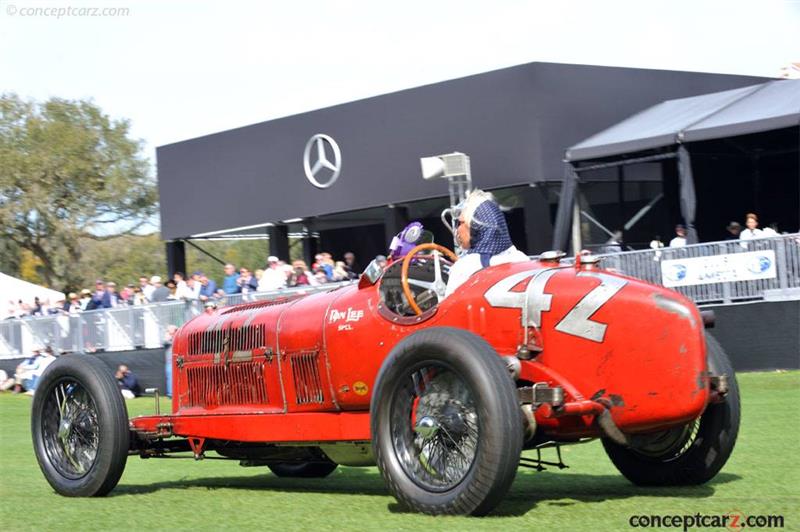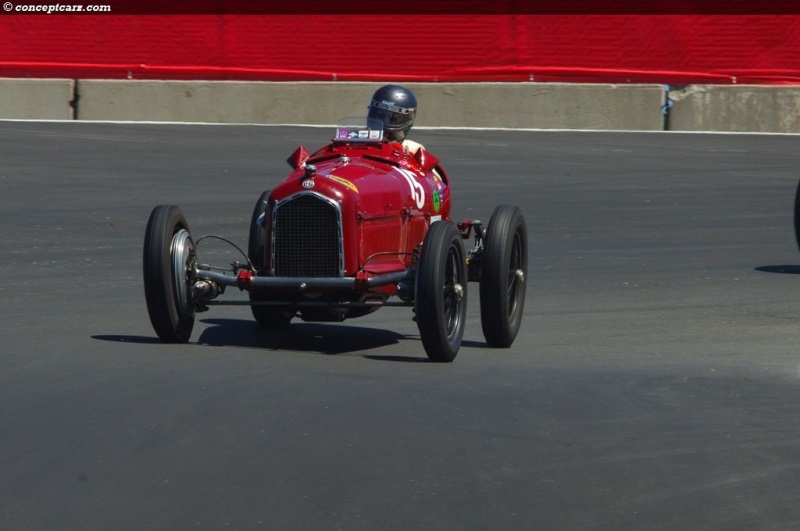History
The Alfa Romeo Tipo B P3 was designed by Vittorio Jano and was Alfa Romeo's second monoposto (single-seater) racer, the first being the Tipo A of 1931. Four Tipo A's had been constructed and none have survived; the closest Tipo A in existence is a replica that now resides in the Alfa Romeo Museum.
The Tipo A had been powered by two six-cylinder engines and matted to two gearboxes and dual propeller shafts. Though much of the design had carried over from the Tipo A, the Tipo B was equipped with a single eight-cylinder engine and drive-train in an effort to reduce the weight of the vehicle. The Tipo B made its inaugural appearance on June 5th, 1932 at the Monza Grand Prix. It was equipped with an eight-cylinder engine similar to the one Jano had created for the road-going 8C 2300. There were differences from the double overhead camshaft unit, such as the engine's intake being mounted on the driver's left side. The engine capacity was larger due to an increase of stroke from 88 to 100 mm. Dual superchargers powered the front and rear testa fissa alloy blocks which resulted in nearly 200 horsepower. The single differential sat behind the three-speed gearbox. Power was sent to each rear wheels thanks to two propeller shafts designed in a triangular setup. These shafts ran beside the driver which allowed a lower sitting position and improved handling characteristics.
At Monza, the Tipo B proved its potential by emerging victorious. In the hands of Tazio Nuvolari and Rudolf Caracciola, the Tipo B dominated the season with wins at the French and German Grand Prix's, among others. Part of its success was its excellent power-to-weight ratio. The body was constructed of aluminum and mechanical drums were used to keep the racer in the driver's control.
The P3 was raced from 1932 through 1935 and provided many podium finishes for its drivers. In 1933 Alfa Romeo retired from racing and soon shifted the racing activities to Scuderia Ferrari. Ferrari's main driver was Tazio Nuvolari. Many of Tipo B cars were sold to privateers. Rule changes in 1934 meant the car was modified to accommodate the new regulations. One of the rules stated that the chassis was to be 33.5 inches wide, which meant the P3 was to be enlarged.
As the years progressed, the car began to show its age. The competition was coming from teams such as Mercedes and Auto Union. Jano and Ferrari worked on improving the car throughout the years. In 1935, Nuvolari's car was given a larger engine, now having a bore of 71mm and a stroke of 100mm. This resulted in a displacement size of 3165cc and horsepower in the 265 neighborhood. Cantilever rear springs were adapted to improve upon the vehicle's performance and handling. Later in the year, some of the Tipo B's were outfitted with hydraulic brakes and Dubonnet independent front suspension.
Nuvolari's most famous and remembered race came in 1935 at the German Grand Prix. His car was now outclassed by the more powerful Mercedes and Auto Union cars. At the end of the race, it was Nuvolari in his Scuderia Ferrari Tipo B outpacing the rest of the competition and finishing in a very impressive and memorable first place.
Near the close of the 1935 season, the engine was again enlarged, now displacing 3822cc and producing 330 horsepower. The chassis was new incorporating a rear transaxle and an independent rear suspension. It was now known as the Tipo C.
By Daniel Vaughan | Feb 2008
The Tipo A had been powered by two six-cylinder engines and matted to two gearboxes and dual propeller shafts. Though much of the design had carried over from the Tipo A, the Tipo B was equipped with a single eight-cylinder engine and drive-train in an effort to reduce the weight of the vehicle. The Tipo B made its inaugural appearance on June 5th, 1932 at the Monza Grand Prix. It was equipped with an eight-cylinder engine similar to the one Jano had created for the road-going 8C 2300. There were differences from the double overhead camshaft unit, such as the engine's intake being mounted on the driver's left side. The engine capacity was larger due to an increase of stroke from 88 to 100 mm. Dual superchargers powered the front and rear testa fissa alloy blocks which resulted in nearly 200 horsepower. The single differential sat behind the three-speed gearbox. Power was sent to each rear wheels thanks to two propeller shafts designed in a triangular setup. These shafts ran beside the driver which allowed a lower sitting position and improved handling characteristics.
At Monza, the Tipo B proved its potential by emerging victorious. In the hands of Tazio Nuvolari and Rudolf Caracciola, the Tipo B dominated the season with wins at the French and German Grand Prix's, among others. Part of its success was its excellent power-to-weight ratio. The body was constructed of aluminum and mechanical drums were used to keep the racer in the driver's control.
The P3 was raced from 1932 through 1935 and provided many podium finishes for its drivers. In 1933 Alfa Romeo retired from racing and soon shifted the racing activities to Scuderia Ferrari. Ferrari's main driver was Tazio Nuvolari. Many of Tipo B cars were sold to privateers. Rule changes in 1934 meant the car was modified to accommodate the new regulations. One of the rules stated that the chassis was to be 33.5 inches wide, which meant the P3 was to be enlarged.
As the years progressed, the car began to show its age. The competition was coming from teams such as Mercedes and Auto Union. Jano and Ferrari worked on improving the car throughout the years. In 1935, Nuvolari's car was given a larger engine, now having a bore of 71mm and a stroke of 100mm. This resulted in a displacement size of 3165cc and horsepower in the 265 neighborhood. Cantilever rear springs were adapted to improve upon the vehicle's performance and handling. Later in the year, some of the Tipo B's were outfitted with hydraulic brakes and Dubonnet independent front suspension.
Nuvolari's most famous and remembered race came in 1935 at the German Grand Prix. His car was now outclassed by the more powerful Mercedes and Auto Union cars. At the end of the race, it was Nuvolari in his Scuderia Ferrari Tipo B outpacing the rest of the competition and finishing in a very impressive and memorable first place.
Near the close of the 1935 season, the engine was again enlarged, now displacing 3822cc and producing 330 horsepower. The chassis was new incorporating a rear transaxle and an independent rear suspension. It was now known as the Tipo C.
By Daniel Vaughan | Feb 2008
Indianapolis VehiclesAdditional Sales Volume Data
Similar Vehicles
Alfa Romeo Monthly Sales Volume
March 2023
2,390
1932 Alfa Romeo P3 Tipo B Vehicle Profiles
Recent Vehicle Additions
Related Automotive News

Phenomenal Ferraris and Italian Thoroughbreds Offered at Gooding & Company's Pebble Beach Auctions
The auction house announced a stable of Italian star cars, including a 1950 Ferrari 166 MM Berlinetta Le Mans, a 1961 Ferrari 400 Superamerica Series I Coupe Aerodinamico, and a 1954 Ferrari 500 Mondial Series I Spider.
A stunning group of star...

Concours of Elegance 2021: The rarest cars in the world
The Concours of Elegance has revealed the full list of vehicles that make up its Main Concours display of the rarest cars in the world
From trailblazing pre-war Grand Prix cars to the very Rolls-Royce that gave birth to the best car in the world...
Luigi Musso: Talented, Tempting and Troubled
Following Alberto Ascaris back-to-back titles in 1952 and 1953 there have been no Italian Formula One World Champions. While there has been a great amount of hope throughout the years, Italians have been left without a World Champion. Perhaps, it could...

120 years of motor sport at Mercedes-Benz take centre stage at the Goodwood Festival of Speed 2014
Addicted to Winning at this years Goodwood Festival of Speed, Mercedes-Benz looks back on some fascinating racing victories of the last 120 years
The unique motor sport heritage of the Mercedes-Benz brand is being celebrated with an exclusive i...

Techno Classica 2014: more than 30 racing cars to celebrate 120 years of Mercedes-Benz motor racing history
Cars that were the heroes of magical moments put their stamp on this high-powered, most comprehensive show presentation
With more than 30 vehicles, Mercedes-Benz Classic presents motor racing history in all its unique breadth and depth
120 years o...





































